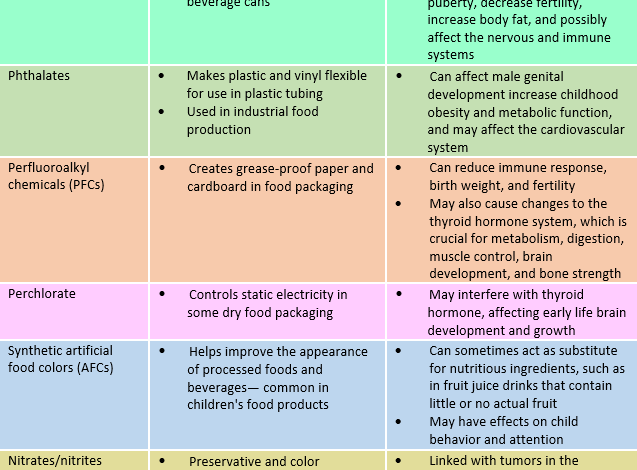Industrial food additives and preservatives

Additives are another inseparable component of industrialized food. Productive, commercial and conservation needs, mean that a large amount of chemical substances are used in the processing of massive foods, which contribute significantly to daily soiling .
The preservatives are a good example. These food preservatives act by inhibiting enzymatic processes (fermentation, putrefaction, etc.). This, which is beneficial for the food that must be kept in a gondola, once ingested, continues to produce enzyme inhibition in our body . This affects the intestinal flora and the liver , whose functions depend on the enzymatic reactions that the preservatives themselves block .
The proof of the prolonged action of these preservatives is given by the problems detected in the United States with the preservation of human corpses . When exhuming coffins of a certain time, the bodies are intact and must be cremated, due to the inhibition that food preservatives generate on the microorganisms responsible for their natural decomposition. The preservatives used in food and beverages can cause exacerbations of asthma, dermatitis, blood disorders (methemoglobinuria) and even be one of the triggers of vascular problems and angioedema [1].
There are also flavor enhancers , such as monosodium glutamate (E621) or ajinomoto . This additive is an exemplary case of how a problem is created, as we will see in detail in the next chapter. After the 2nd World War, MSG passed from Japan to the large food companies in the US, who spread its use when they discovered that even mediocre industrial foods tasted good, they ate more and people became loyal consumers.
Initially, it was noticed that the ingestion of MSG generated the well-known “ Chinese restaurant syndrome ”, so called because it is very frequently used in modern oriental cuisine [2]. But then other worrying evidences appeared that were not taken into account, as GMS became the addictive gear that drove the growth of the large food industry; The term food nicotine was cleverly coined .
Through experiences in animals and later in humans, MSG was associated with attention deficit (ADD), addiction, alcoholism, allergies, amyotrophic lateral sclerosis, Alzheimer’s, asthma, atrial fibrillation, autism, diabetes, depression, dizziness, epilepsy, fibromyalgia, heat stroke, hypertension, hypothyroidism, hypoglycemia, irritable bowel syndrome, inflammation, migraine, multiple sclerosis, obesity, pituitary tumors, panic attacks, rosacea, sleep disorders, ear problems (tinnitus), vision problems [3].
However, MSG is still ubiquitous in cold cuts, hamburgers, snacks, spice mixes, preserved and processed foods, packet soups, bouillon cubes, French fries, restaurant meals, salad dressings, seasonings for grilled meats, sauces, mayonnaise , etc. Tons of MSG are served in factory, school and hospital cafeterias.
Faced with the demand for food without MSG, manufacturers hid glutamate under new names of ingredients authorized by control bodies: hydrolyzed vegetable protein, natural meat softener, flavor enhancer, yeast extract, natural flavoring, etc.
The colorants represent another important item of the additives that we ingest daily and unnecessarily, since they only serve to deceive the consumer. Chemical synthesis dyes accumulate a large amount of toxic and carcinogenic evidence. The most characteristic and studied is perhaps tartrazine , and it is suitable to analyze it as an example.
This additive (sometimes disguised as E102), which provides a yellowish-red color to artificial juices, jellies, sodas, desserts, sauces, preserves, drug coatings and candies, is recognized as responsible for allergic reactions, asthma, hives, rhinitis, spots on the skin, blurred vision and bronchial spasms, especially in patients allergic to aspirin. But the most harmful effect is seen in its main recipients: it can cause migraines, insomnia and hyperactivity in children .
Tartrazine directly affects the behavior of children in two ways: it awakens a pseudo-allergic reaction in the body and causes the consequent release of histamine, a compound related to the immune reaction. But, when the dye reaches the bloodstream, it directly stimulates cells to release histamine without activating the immune system . For this reason, the symptoms of allergy such as dilation of capillaries, low blood pressure, increased secretion of gastric juices and itching do not appear. But there are mood changes, irritability, insomnia and anxiety in children .
Simultaneously, tartrazine acts in the brain by altering the synaptic spaces (where the exchange of information between one neuron and another takes place), which leads to similar symptoms: lack of concentration, drowsiness and hyperactivity. That is, the picture of an attention deficit syndrome (ADD). It is enough to be a regular consumer of, for example, artificial juices, for these symptoms to become present. This happens because the continuous dose and the rapid arrival of the toxic threshold are combined, due to the low body mass of children. The relationship between the consumption of dye and the increase in histamine levels is directly proportional.
But the most serious thing is that colorants, such as tartrazine, do not act alone , but are part of formulations that include flavorings, flavorings, sweeteners, emulsifiers, gelling agents, surfactants, leavening agents, anticaking agents, stabilizers, antioxidants, thickeners and preservatives. Precisely a recent British study [4] shows that the combination of artificial colors and preservatives (sodium benzoate) negatively influences the behavior of children with attention deficit hyperactivity disorder (ADHD).
The «harmless» flavored waters consumed by » people who take care of themselves «, concentrate a large number of threatening presences, hidden under intelligible numerical acronyms ( 17 components on a single label). In addition to water and juice, we find: refined sweeteners (high fructose corn syrup), synthetic sweeteners (sucralose and acesulfame), calcium chloride, sodium bicarbonate, magnesium sulfate (English salt), acidulants (330, 331), preservatives (202, 211), sequestrants (385), artificial essences (two), colorants (110, 150).
What ‘s behind some of these numbers ? Among the colorants we find 110 (sunset yellow), considered dangerous (depressant of the nervous system, can cause allergies, paralysis, seizures, hives, dermatosis, gastric disorders) and 150 (caramel), also dangerous (can produce alterations in the intestine , vitamin B6 deficiencies and decreased red blood cells).
Among the preservatives we have 202 (potassium sorbate), considered very dangerous (it can react with nitrites and cause alterations in sperm and ovules, and cause allergies) and 211 (sodium benzoate), also very dangerous (it can be carcinogenic and cause gastritis , neurological disorders, weight loss, diarrhea, bleeding, paralysis, allergies, hives, asthma, liver disorders and hyperactivity in children).
And as if that were not enough, we have 385 (ethylenediamine tetracetate), normally used in alcoholic beverages as a sequestrant and considered dangerous (it can cause diarrhea, vomiting, blood in the urine and prevent the absorption of trace elements such as copper, iron, zinc). By common sense, is there a reason to take all these risks ? Is it necessary to flavor the water? If it is, isn’t it better to “ flavor ” the water with a few drops of lemon and a teaspoon of honey or muscabo ?
But now what’s new for kids is interactive food and drink . We refer to products that change color, shape, texture or flavor when adding liquids or heating them; pancakes that change their appearance when toasted, a soda that changes its flavor if you add a pill or ice cream with gum inside, which paints the lips in different colors.
It is remarkable (and alarming) that the legislation approves these chemical additives as suitable for human consumption , based on tolerances and studies carried out individually, when in fact they enter the body in nourishing and dangerous synergistic combinations . A German study estimates that more than 2kg of chemical additives are ingested annually per person .
The problem is its relationship with body mass, since there are children who are ingesting up to 400 mg of additives daily , almost 8 times the dose used in laboratory experiments to demonstrate their individual safety. Even many additives are authorized based on an “ accepted daily dose ”, but the manufacturers do not indicate, neither that dose nor the amount of additive present in the food .
[1] Localized vascular reaction, which affects the skin, subcutaneous tissue and mucosa. It manifests as a swelling. [2] Symptoms consisted of: headaches, chest tightness, a sensation of heat and tingling, stiffness and / or weakness in the extremities, lightheadedness, facial flushing, and gastric discomfort. [3] See www.spofamerica.com, site of John Edward Erb, author of the book «The Slow Poisoning of America» and www.msgtruth.org [4] Study of the University of Southampton (GB), published in The Lancet, in September 2007.
purifying space




![Photo of How to Plant Jujube: [Complete Guide]](https://www.complete-gardening.com/wp-content/uploads/2022/08/how-to-plant-jujube-complete-guide-390x220.jpg)